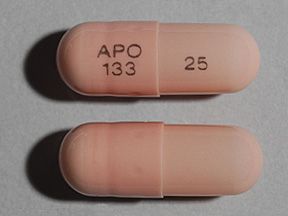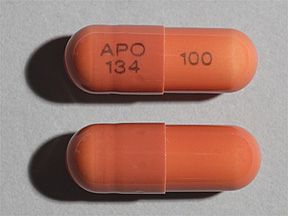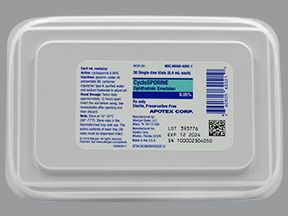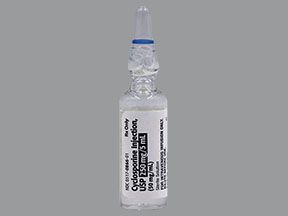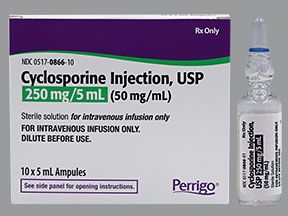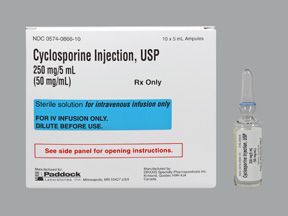Cyclosporine is an immunosuppressant used to to treat psoriasis and rheumatoid arthritis. It’s also used to in organ transplants. However, it does have some potentially serious side effects.
This drug has boxed warnings. A boxed warning is the most serious warning from the Food and Drug Administration (FDA). It alerts doctors and patients about drug effects that may be dangerous.
- Infection warning: Cyclosporine may increase your risk of serious infections. It may also increase your risk of developing a tumor or skin cancer.
- Skin disease warning: If you have psoriasis and have been treated with either psoralen plus ultraviolet A therapy, methotrexate, coal tar, radiation therapy, or ultraviolet light therapy, you may have a higher chance of developing a skin disease while taking cyclosporine capsules.
- High blood pressure and kidney disease warning: This medication may cause high blood pressure and kidney disease.
- Experienced physician warning: Only healthcare providers experienced in the management of systemic immunosuppressive therapy for the disease being treated should prescribe cyclosporine. “Systemic immunosuppressive therapy” is treatment for autoimmune diseases (in which a person’s immune system attacks their own body).
- Bioavailability warning: The absorption of Sandimmune (cyclosporine non-modified) capsules and oral solution during long-term use may become unpredictable. It’s recommended that people taking Sandimmune capsules or oral solution over a period of time be monitored for cyclosporine blood levels to avoid toxicity and possible organ rejection.
- Gengraf and Neoral warning: Gengraf and Neoral (cyclosporine modified) are absorbed more by the body compared with Sandimmune capsules and oral solution. So these drugs can’t be used interchangeably without the supervision of a healthcare provider.
- Cyclosporine oral capsule is available as a generic drug and as brand-name drugs. Brand names: Gengraf, Neoral, Sandimmune. Please note that Neoral and Gengraf (cyclosporine modified) aren’t absorbed in the same way as Sandimmune (cyclosporine non-modified) is, so these drugs can’t be used interchangeably.
- Cyclosporine comes as an oral capsule, an oral solution, eye drops, and an injectable form.
- Cyclosporine oral capsule is used to treat inflammation in rheumatoid arthritis and psoriasis. It’s also used to prevent the rejection of an organ transplant.
Cyclosporine is a prescription drug. It comes as an oral capsule, an oral solution, and eye drops. It also comes in an injectable form, which is only given by a healthcare provider.
Cyclosporine oral capsule is available as the brand-name drugs Gengraf, Neoral, and Sandimmune. It’s also available as a generic drug.
Generic drugs usually cost less than the brand-name version. In some cases, they may not be available in all strengths or forms as the brand-name drug.
Please note that Neoral and Gengraf can’t be used interchangeably with Sandimmune.
Why it’s used
Cyclosporine is used to prevent rejection of a transplanted organ. It’s also used to reduce inflammation in active rheumatoid arthritis (RA) and severe psoriasis.
The brand-name version called Sandimmune is only used to prevent rejection of a transplanted organ.
How it works
Cyclosporine belongs to a class of drugs called immunosuppressants. A class of drugs is a group of medications that work in a similar way. These drugs are often used to treat similar conditions.
Cyclosporine works by weakening your immune system. White blood cells, part of your immune system, normally fight substances in your body that aren’t there naturally, such as a transplanted organ. Cyclosporine stops white blood cells from attacking a transplanted organ.
In the case of RA or psoriasis, cyclosporine stops your immune system from mistakenly attacking your own body tissues.
Cyclosporine can cause mild or serious side effects. The following list contains some of the key side effects that may occur while taking cyclosporine.
This list doesn’t include all possible side effects. For more information on the possible side effects of cyclosporine, or tips on how to deal with a troubling side effect, talk with your doctor or pharmacist.
Cyclosporine oral capsule doesn’t cause drowsiness.
More common side effects
The more common side effects that occur with cyclosporine include:
- high blood pressure
- low magnesium levels in your body
- blood clots in your kidneys
- stomach pain
- hair growth in certain areas
- acne
- tremors
- headache
- increased size of your gums
If these effects are mild, they may go away within a few days or a couple of weeks. If they’re more severe or don’t go away, talk to your doctor or pharmacist.
Serious side effects
Call your doctor right away if you have serious side effects. Call 911 if your symptoms feel life threatening or if you think you’re having a medical emergency. Serious side effects and their symptoms can include the following:
Liver damage. Symptoms may include:
- blood in urine
- dark urine
- pale stools
- yellowing of your skin or the whites of your eyes
- pain in your upper abdomen
Kidney damage. Symptoms may include:
- blood in urine
Heart problems. Symptoms may include:
- swelling of your feet or lower legs
Lung problems. Symptoms may include:
- trouble breathing
The cyclosporine dosage your doctor prescribes will depend on several factors. These include:
- the type and severity of the condition you’re using cyclosporine to treat
- your age
- the form of cyclosporine you take
- other medical conditions you may have
Typically, your doctor will start you on a low dosage and adjust it over time to reach the dosage that’s right for you. They’ll ultimately prescribe the smallest dosage that provides the desired effect.
The following information describes dosages that are commonly used or recommended. However, be sure to take the dosage your doctor prescribes for you. Your doctor will determine the best dosage to suit your needs.
All possible dosages and forms may not be included here.
Dosage for rheumatoid arthritis
Generic: Cyclosporine
- Form: oral capsule
- Strengths: 25 milligrams (mg), 50 mg, and 100 mg
Brand: Gengraf
- Form: oral capsule
- Strengths: 25 mg and 100 mg
Brand: Neoral
- Form: oral capsule
- Strengths: 25 mg and 100 mg
Adult dosage (ages 18 years and older)
Dosage is based on weight.
- Typical starting dosage: 2.5 milligrams per kilogram (mg/kg) per day, divided into two doses (1.25 mg/kg per dose).
- Maximum dosage: 4 mg/kg per day.
- Note: If you don’t have good results after 16 weeks of treatment, your doctor will have you stop taking cyclosporine.
Child dosage (ages 0–17 years)
Dosage hasn’t been established for people younger than 17 years old.
Dosage for psoriasis
Generic: Cyclosporine
- Form: oral capsule
- Strengths: 25 mg, 50 mg, and 100 mg
Brand: Gengraf
- Form: oral capsule
- Strengths: 25 mg and 100 mg
Brand: Neoral
- Form: oral capsule
- Strengths: 25 mg and 100 mg
Adult dosage (ages 18 years and older)
Dosage is based on weight.
- Typical starting dosage: 2.5 mg/kg per day, divided into two doses (1.25 mg/kg per dose).
- Maximum dosage: 4 mg/kg per day.
- Note: If you don’t have good results after 6 weeks at the maximum tolerated dose, your doctor will have you stop taking cyclosporine.
Child dosage (ages 0–17 years)
Dosage hasn’t been established for people younger than 17 years old.
Dosage to prevent rejection of kidney, liver, and heart transplants
Generic: Cyclosporine
- Form: oral capsule
- Strengths: 25 mg, 50 mg, and 100 mg
Brand: Gengraf
- Form: oral capsule
- Strengths: 25 mg and 100 mg
Brand: Neoral
- Form: oral capsule
- Strengths: 25 mg and 100 mg
Brand: Sandimmune
- Form: oral capsule
- Strengths: 25 mg and 100 mg
Adult dosage (ages 18 years and older)
The dosage of cyclosporine may vary, depending on your body weight, the organ that has been transplanted, and other medications you’re taking.
- Neoral, Gengraf, and generics: Dosage may vary. The typical daily dosage is 7–9 milligrams per kilogram (mg/kg) of body weight taken in two even doses spaced evenly throughout the day.
- Sandimmune and generic:
- Take your first dose 4–12 hours before your transplant. This dose is typically 15 mg/kg. Your doctor may give you a dosage that’s 10–14 mg/kg per day.
- Continue taking the same dosage after your transplant surgery for 1–2 weeks. After that, reduce it by 5 percent per week to a maintenance dosage of 5–10 mg/kg per day.
Child dosage (ages 1–17 years)
The dosage of cyclosporine will vary depending on your child’s body weight, the organ that has been transplanted, and other medications your child is taking.
- Neoral, Gengraf, and generics: Dosage may vary. The typical initial daily dosage is 7–9 milligram per kilogram (mg/kg) of body weight divided in two equal daily doses.
- Sandimmune and generic:
- Take your first dose 4–12 hours before your transplant. This dose is typically 15 mg/kg. Your doctor may give you a dosage that’s 10–14 mg/kg per day.
- Continue taking the same dosage after your transplant surgery for 1–2 weeks. After that, reduce it by 5 percent per week to a maintenance dosage of 5–10 mg/kg per day.
Child dosage (ages 0–11 months)
Dosage hasn’t been established for children younger than 12 months.
Special dosage considerations
- For people with kidney disorders: Cyclosporine may cause kidney disease. If you already have kidney problems, your doctor may prescribe a reduced dosage of cyclosporine.
- For people with liver disorders: Cyclosporine may cause liver disease. If you already have liver problems, your doctor may prescribe a reduced dosage of cyclosporine.
Cyclosporine is used for long-term treatment. It comes with serious risks if you don’t take it as prescribed.
If you stop taking the drug or don’t take it at all: Your body may reject your transplanted organ or your symptoms of RA or psoriasis may return.
If you miss doses or don’t take it on schedule: Your body may reject your transplant, causing serious health problems. Or your symptoms of RA or psoriasis may return.
If you take too much: You could have dangerous levels of the drug in your body. Symptoms of an overdose of this drug can include:
- yellowing of your skin or the whites of your eyes
- swelling of your arms, hands, feet, ankles, or lower legs
If you think you’ve taken too much of this drug, call your doctor or seek guidance from the American Association of Poison Control Centers at 800-222-1222 or through their online tool. But if your symptoms are severe, call 911 or go to the nearest emergency room right away.
What to do if you miss a dose: If you miss a dose, take it as soon as you can. However, if it’s just a few hours until your next dose, skip the missed dose.
Don’t try to catch up by taking two doses at once. This could result in dangerous side effects.
How to tell if the drug is working: You may be able to tell the drug is working if:
- your body doesn’t reject the transplanted organ or tissue
- you have fewer RA symptoms
- you have fewer psoriasis plaques
This drug comes with various warnings.
FDA warnings
- This drug has black box warnings. A black box warning is the most serious warning from the Food and Drug Administration (FDA). A black box warning alerts doctors and patients about drug effects that may be dangerous.
- Infection warning. Cyclosporine may increase your risk of serious infections. It may also increase your risk of developing a tumor or skin cancer.
- Skin disease warning. If you have psoriasis and have been treated with either psoralen plus ultraviolet A therapy, methotrexate, coal tar, radiation therapy, or ultraviolet light therapy, you may have a higher chance of developing a skin disease while taking cyclosporine capsules.
- High blood pressure and kidney disease warning. This medication may cause high blood pressure and kidney disease.
- Experienced physician warning. Only healthcare providers experienced in the management of systemic immunosuppressive therapy for the indicated disease should prescribe cyclosporine. “Systemic immunosuppressive therapy” is treatment for autoimmune diseases (in which a person’s immune system attacks their own body).
- Bioavailability warning. The absorption of Sandimmune (cyclosporine non-modified) capsules and oral solution during long-term usage may become unpredictable. It’s recommended that people taking Sandimmune capsules or oral solution over a period of time be monitored for cyclosporine blood levels to avoid toxicity and possible organ rejection.
- Gengraf and Neoral warning. Gengraf and Neoral (cyclosporine modified) are absorbed more by the body compared with Sandimmune capsules and oral solution. So these drugs can’t be used interchangeably without the supervision of a healthcare provider.
Liver damage warning
Taking cyclosporine may cause liver damage and liver failure, especially if you take high doses. It may even be fatal.
High potassium levels warning
Taking this drug may raise your potassium levels.
Food interactions warning
Avoid eating grapefruit or drinking grapefruit juice when taking this medication. Consuming grapefruit products can increase the amount of cyclosporine in your body.
Warnings for people with certain health conditions
For people with kidney and liver disorders: Cyclosporine may cause kidney and liver disease. If you already have kidney or liver problems, high doses of cyclosporine may make it worse.
For people with serious infections: Cyclosporine may increase your risk of serious viral infections, such as polyomavirus infection. This may be very serious, even fatal.
Warnings for other groups
For pregnant women: Cyclosporine is a category C pregnancy drug. That means two things:
- Research in animals has shown adverse effects to the fetus when the mother takes the drug.
- There haven’t been enough studies done in humans to be certain how the drug might affect the fetus.
Talk with your doctor if you’re pregnant or plan to become pregnant. Cyclosporine should be used during pregnancy only if the potential benefit justifies the potential risk to the fetus.
For women who are breastfeeding: Cyclosporine passes through breast milk and may cause serious negative effects. Tell your doctor if you’re breastfeeding. You and your doctor need to decide if you’ll breastfeed or take cyclosporine.
Brand-name Sandimmune capsules contain ethanol (alcohol). Ethanol and other substances in the drug may pass through breast milk and cause serious effects in a child who is breastfed.
For seniors: If you’re 65 years or older, you’re more likely to develop high blood pressure if you use cyclosporine. As you age, your organs, such as your liver and kidneys, don’t work as well as they once did. To prevent kidney damage, your doctor may start you on a lower dose.
For children:
- Who have had a kidney, liver, or heart transplant: Children ages 6 months and older who received certain organ transplants and were treated with cyclosporine didn’t have unusual side effects.
- Who have rheumatoid arthritis or psoriasis: This drug hasn’t been established as safe or effective for use in people younger than 18 years who have rheumatoid arthritis or psoriasis.
Cyclosporine can interact with several other medications. Different interactions can cause different effects. For instance, some can interfere with how well a drug works, while others can cause increased side effects.
Below is a list of medications that can interact with cyclosporine. This list doesn’t contain all drugs that may interact with cyclosporine.
Before taking cyclosporine, be sure to tell your doctor and pharmacist about all prescription, over-the-counter, and other drugs you take. Also tell them about any vitamins, herbs, and supplements you use. Sharing this information can help you avoid potential interactions.
If you have questions about drug interactions that may affect you, ask your doctor or pharmacist.
Antibiotics
Taking cyclosporine with certain antibiotics may lead to an increased risk of kidney damage. Examples of these drugs include:
- ciprofloxacin
- gentamicin
- tobramycin
- trimethoprim/sulfamethoxazole
- vancomycin
The following antibiotics may lead to higher levels of cyclosporine in your body. This may increase your risk of side effects. Examples of these drugs include:
- azithromycin
- clarithromycin
- erythromycin
- quinupristin/dalfopristin
The following antibiotics may decrease the amount of cyclosporine in your body. This may cause cyclosporine not to work as well as it should. When cyclosporine is used to prevent organ rejection, this could lead to rejection of a transplanted organ. These drugs include:
- nafcillin
- rifampin
Nonsteroidal anti-inflammatory drugs (NSAIDs)
Taking cyclosporine with these drugs may increase your risk of kidney damage. Examples of these drugs include:
- ibuprofen
- sulindac
- naproxen
- diclofenac
Antifungals
Taking cyclosporine with certain antifungal drugs may lead to higher levels of cyclosporine in your body. This could cause increased side effects or raise your risk of kidney damage. Examples of these drugs include:
- amphotericin B
- ketoconazole
- fluconazole
- itraconazole
- voriconazole
Terbinafine, another antifungal, may decrease the amount of cyclosporine in your body. This may cause cyclosporine not to work as well as it should. When cyclosporine is used to prevent transplant rejection, this could lead to rejection of a transplanted organ.
Acid reflux drugs
Taking cyclosporine with these drugs may increase your risk of kidney damage. Examples of these drugs include:
- cimetidine
Birth control drugs
Taking cyclosporine with drugs used for birth control may increase the amount of cyclosporine in your body. This may cause harmful side effects.
Immunity-suppressing drug
Taking tacrolimus with cyclosporine can increase your risk of kidney damage.
High cholesterol drugs
Taking cyclosporine with the following cholesterol drugs may increase your risk of kidney damage:
- fenofibrate
- gemfibrozil
When you take cyclosporine with other cholesterol drugs, the concentration of these drugs in your body may increase. This may cause side effects such as muscle pain and weakness. These drugs include:
- atorvastatin
- simvastatin
- lovastatin
- pravastatin
- fluvastatin
Blood pressure drugs
Taking these drugs with cyclosporine may increase the amount of cyclosporine in your body. This may cause harmful side effects. Examples of these drugs include:
- diltiazem
- nicardipine
- verapamil
Corticosteroid
Taking methylprednisolone with cyclosporine may increase the amount of cyclosporine in your body. This may cause harmful side effects.
Anticonvulsants
Taking these drugs with cyclosporine may decrease the amount of cyclosporine in your body. This may cause cyclosporine not to work as well as it should. When cyclosporine is used to prevent organ rejection, this could lead to rejection of a transplanted organ. Examples of these drugs include:
- carbamazepine
- oxcarbazepine
- phenobarbital
- phenytoin
Herb
Taking St. John’s wort with cyclosporine may decrease the amount of cyclosporine in your body. This may cause cyclosporine not to work as well as it should. When cyclosporine is being used to prevent organ rejection, this could lead to rejection of a transplanted organ.
Gout drugs
Taking allopurinol with cyclosporine can increase the amount of cyclosporine in your body. This may increase your risk of side effects.
Taking colchicine with cyclosporine may increase your risk of kidney damage.
HIV drugs
If you’re taking drugs called protease inhibitors to treat HIV, check with your doctor before taking cyclosporine. Your doctor may need to reduce your dose of cyclosporine to prevent side effects that can be caused by taking these drugs with cyclosporine. Examples of these drugs include:
- indinavir
- nelfinavir
- ritonavir
- saquinavir
Fluid-reducing drugs
Don’t take cyclosporine with these drugs. It may increase the amount of potassium in your body and may cause harmful side effects. These side effects may include a slow heart rate, fatigue, muscle weakness, and nausea. Examples of these drugs include:
- triamterene
- amiloride
Cancer drugs
Taking cyclosporine with certain drugs used to treat cancer may increase the amounts of those medications in your body. This may increase your risk of side effects. Examples of these drugs include:
- daunorubicin
- doxorubicin
- etoposide
- mitoxantrone
Taking melphalan, another cancer drug, with cyclosporine may increase your risk of kidney damage.
Other drugs
Taking cyclosporine with any of the medications listed below may cause increased amounts of those medications in your body. This may increase your risk of side effects. Examples of these drugs include:
- ambrisentan
- aliskiren
- bosentan
- dabigatran
- digoxin
- prednisolone
- repaglinide
- sirolimus
Other drugs may increase the amount of cyclosporine in your body. This may cause harmful side effects. Examples of these drugs include:
- amiodarone
- bromocriptine
- danazol
- imatinib
- metoclopramide
- nefazodone
Other drugs may decrease the amount of cyclosporine in your body. This may cause cyclosporine not to work as well as it should. When cyclosporine is used to prevent organ rejection, this could lead to rejection of a transplanted organ. Examples of these drugs include:
- bosentan
- octreotide
- orlistat
- sulfinpyrazone
- ticlopidine
Keep these considerations in mind if your doctor prescribes cyclosporine for you.
General
- Take cyclosporine at the same time every day.
- Don’t crush, chew, or cut cyclosporine capsules.
- Note that you may detect an odor when you open the container for the first time. This will disappear over time.
Storage
- Store at room temperature between 68°F and 77°F (20°C and 25°C).
- Keep this drug away from light and high temperature.
- Don’t store this medication in moist or damp areas, such as bathrooms.
Refills
A prescription for this medication is refillable. You shouldn’t need a new prescription for this medication to be refilled. Your doctor will write the number of refills authorized on your prescription.
Travel
When traveling with your medication:
- Always carry your medication with you. When flying, never put it into a checked bag. Keep it in your carry-on bag.
- Don’t worry about airport X-ray machines. They can’t hurt your medication.
- You may need to show airport staff the pharmacy label for your medication. Always carry the original prescription-labeled container with you.
- Don’t put this medication in your car’s glove compartment or leave it in the car. Be sure to avoid doing this when the weather is very hot or very cold.
- Talk to your pharmacist before you travel to be sure you have enough of this medication. Depending on where you travel, you may have trouble getting this drug.
Self-management
If you’re taking generic cyclosporine or a brand-name drug other than Sandimmune, avoid excessive sunlight or tanning booths.
Clinical monitoring
Your doctor may monitor you with certain blood tests before and during treatment with cyclosporine. This is to make sure it’s safe for you to take. Tests may be done to check things such as your:
- cyclosporine levels
- liver function
- kidney function
- cholesterol levels
- magnesium level
- potassium level
Availability
Not every pharmacy stocks this drug. When filling your prescription, be sure to call ahead to make sure your pharmacy carries it.
Prior authorization
Many insurance companies require a prior authorization for this drug. This means your doctor will need to get approval from your insurance company before your insurance company will pay for the prescription.
There are other drugs available to treat your condition. Some may be better suited for you than others. Talk to your doctor about other drug options that may work for you.
Disclaimer: Healthline has made every effort to make certain that all information is factually correct, comprehensive, and up to date. However, this article should not be used as a substitute for the knowledge and expertise of a licensed healthcare professional. You should always consult your doctor or other healthcare professional before taking any medication. The drug information contained herein is subject to change and is not intended to cover all possible uses, directions, precautions, warnings, drug interactions, allergic reactions, or adverse effects. The absence of warnings or other information for a given drug does not indicate that the drug or drug combination is safe, effective, or appropriate for all patients or all specific uses.










